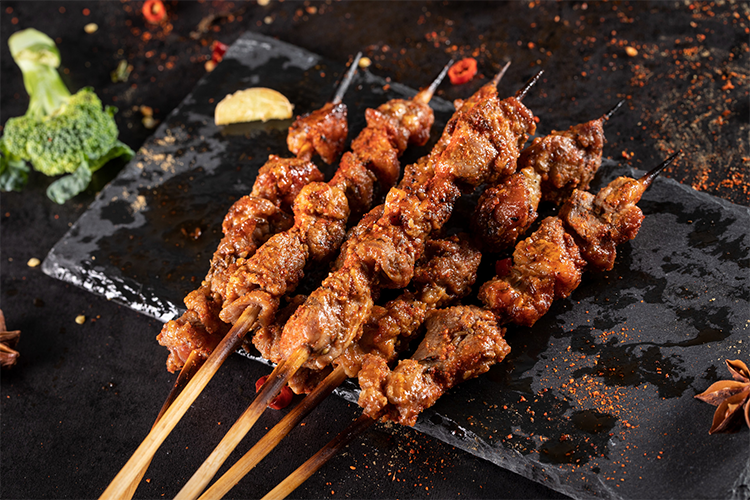Xinjiang Lamb Skewers: A Traveler’s Guide to Silk Road Flavors
1. Introduction
When you set foot on the vast, mysterious land of Xinjiang, beyond its snow-capped peaks, lakes, and deserts, one scent will grab your senses immediately—the irresistible aroma of grilled lamb skewers. This is more than food; it’s a millennium-spanning taste journey, a symbol of Xinjiang hospitality and the lively street-food culture of the Silk Road. Get your appetite ready and discover the grand story behind this humble skewer.
2. Origin and 1,800-Year History
Xinjiang lamb skewers compress frontier life into one delicious tale. Their origins trace back more than 1,800 years to the Han dynasty and rose alongside Silk Road trade. Travelers and shepherds devised a portable, energy-rich way to eat on long journeys: large pieces of lamb threaded on red-willow sticks, cooked over scarce brush fires and seasoned simply with salt. The result was bold, smoky, and nourishing. Over centuries, this practical food evolved into one of Xinjiang’s culinary gems, reflecting centuries of cultural exchange.
3. Deep Cultural Meaning and Hospitality
In Xinjiang, grilled lamb skewers are far more than sustenance; they are deeply woven into social life. For the warm and generous peoples of the region, serving lamb skewers is one of the highest gestures of hospitality. At family gatherings, festivals, or when welcoming distant guests, hosts present sizzling, oil-dripping skewers. More skewers and larger pieces usually signal greater respect and affection. This sharing tradition perfectly captures Xinjiang’s boisterous, hospitable spirit—enjoying a hearty kebab meal is one of the most direct and joyful ways to experience local culture.

4. The Secret of Simple Ingredients
The irresistible charm of authentic Xinjiang lamb skewers lies in the purity of ingredients.
– Lamb: Choose fresh leg or rib cuts with a balance of fat and lean, usually from sheep. Local Xinjiang flocks feed on alkaline grasses and mountain waters, producing tender, lightly flavored meat with a rich, natural aroma.
– Seasoning: Minimal and meant to enhance rather than mask the meat. Salt is the base; ground cumin (the soul of the dish) adds a warm, exotic aroma; chili powder is optional for heat. Traditionally, onion is used in a simple marinade to tenderize the meat and add juiciness.
5. The Craft of Grilling
Watching the grilling is as enjoyable as tasting. Traditional Xinjiang grill masters—known in Uyghur as kawapchi—are artists.
1. Cutting and threading: The lamb is cut into evenly sized cubes and threaded alternately fat and lean onto metal skewers or red-willow sticks. The red-willow releases a unique fragrance during grilling.
2. Grilling: Skewers are placed close together over long clay pits or smokeless coal grills. Masters skillfully turn hundreds of skewers to ensure even heat.
3. Seasoning: When the meat reaches medium doneness, cumin and chili are sprinkled; the spices meet hot oil and release an intense, enticing aroma.
4. Finishing: When the exterior is golden and slightly charred and the interior remains pink and juicy, the skewers are taken off the fire and served hot.
6. Flavor and Texture
A perfect Xinjiang skewer is a multi-sensory feast—visual, auditory, aromatic, and flavorful. “Crispy outside, tender inside” sums it up. The first bite yields a faint crackle from the slightly charred crust, followed by a burst of rich, piping-hot juices. Cumin’s exotic scent, a touch of chili’s warmth, and lamb’s pure, deep flavor mingle perfectly. Fat portions become glossy and caramelized, never greasy. This bold, direct taste experience is utterly satisfying.

7. Authentic Ways to Eat and Pairings
Locals follow a ritual when enjoying skewers:
– Essential companion: freshly baked nang (naan-style flatbread). Tear a piece and wrap the skewer meat in it—this is the most authentic way to eat, balancing richness with bread.
– To refresh: a bowl of thick brick tea or a cold bottle of Wusu beer cuts through the fat and complements the meal. Many local men enjoy a chilled “Wusu” beer for a hearty finish.
– Hands-on: Don’t be shy—eating with your hands is the most genuine way to experience this bold dish.
8. Practical Tips for Food Travelers
– Where to eat: You don’t need a fancy restaurant. Urumqi’s International Grand Bazaar, local night markets, and busy roadside stalls often serve the most authentic skewers. Follow the queues of locals.
– Price guide: Very affordable and usually sold by skewer. Typical skewers cost around 3–8 RMB each; larger chunks or those on red-willow sticks may be 10–20 RMB.
– Ordering tip: A simple phrase like “Boss, X skewers please!” or pointing at the number works fine.
– Spice caution: If you can’t handle heat, request “no chili” or “mild chili.”
9. Easy Home Recipe for Travelers
You can recreate a home version outside Xinjiang:
1. Cut lamb into 2cm cubes and marinate for 30 minutes with chopped onion, a small amount of salt, and egg white.
2. Thread alternating fat and lean pieces onto bamboo or metal skewers.
3. Preheat oven to 200°C or prepare a charcoal grill.
4. Turn often while grilling; when the meat starts to turn opaque, sprinkle cumin, chili powder, and salt.
5. Remove when the exterior is slightly charred and oil begins to glisten. Serve with store-bought nang for a family-style Xinjiang feast.

10. Conclusion
Xinjiang lamb skewers are a skewer through time—linking vast history, diverse cultures, and genuine warmth. They are more than a culinary thrill; they embody a bold way of life. When you plan your Xinjiang trip, put these skewers at the top of your must-try list. Step into the smoke-filled stalls, order a generous handful of skewers, pair them with nang and hot tea, and savor one of the most memorable, heartwarming food experiences your journey can offer. Welcome to Xinjiang—taste the thousand-year flame that never dies.


